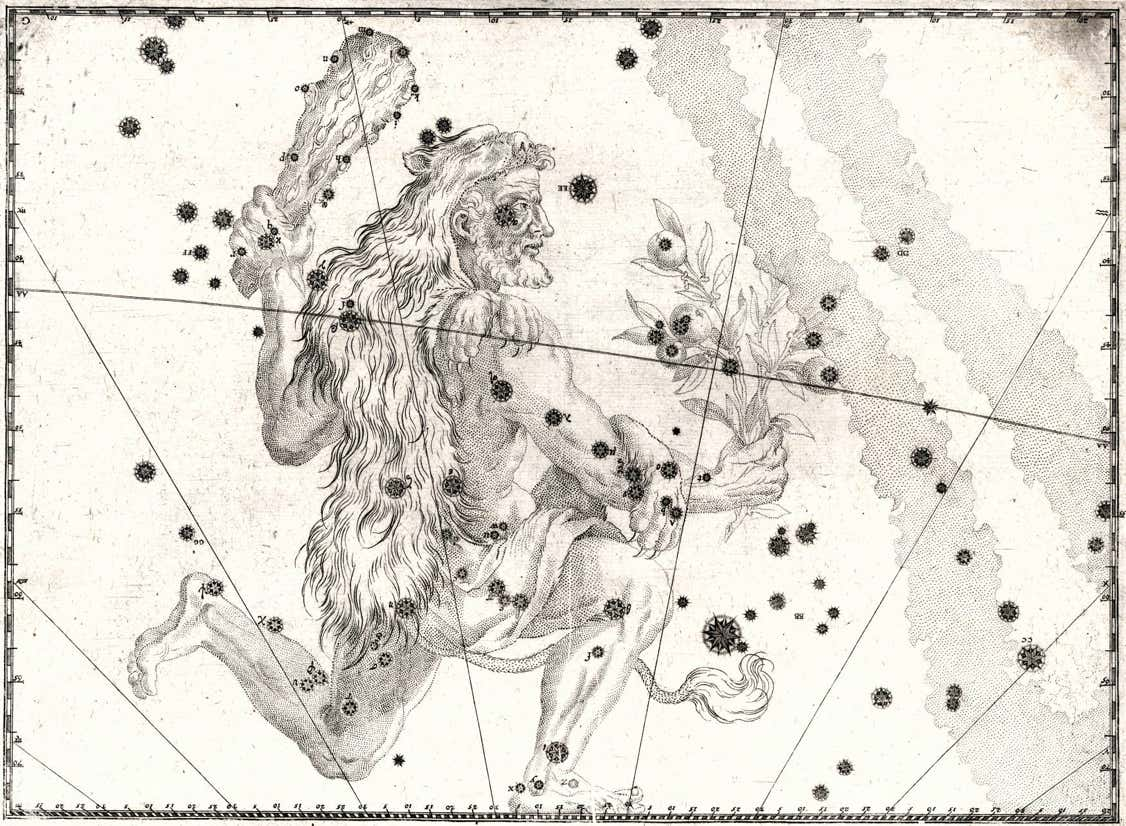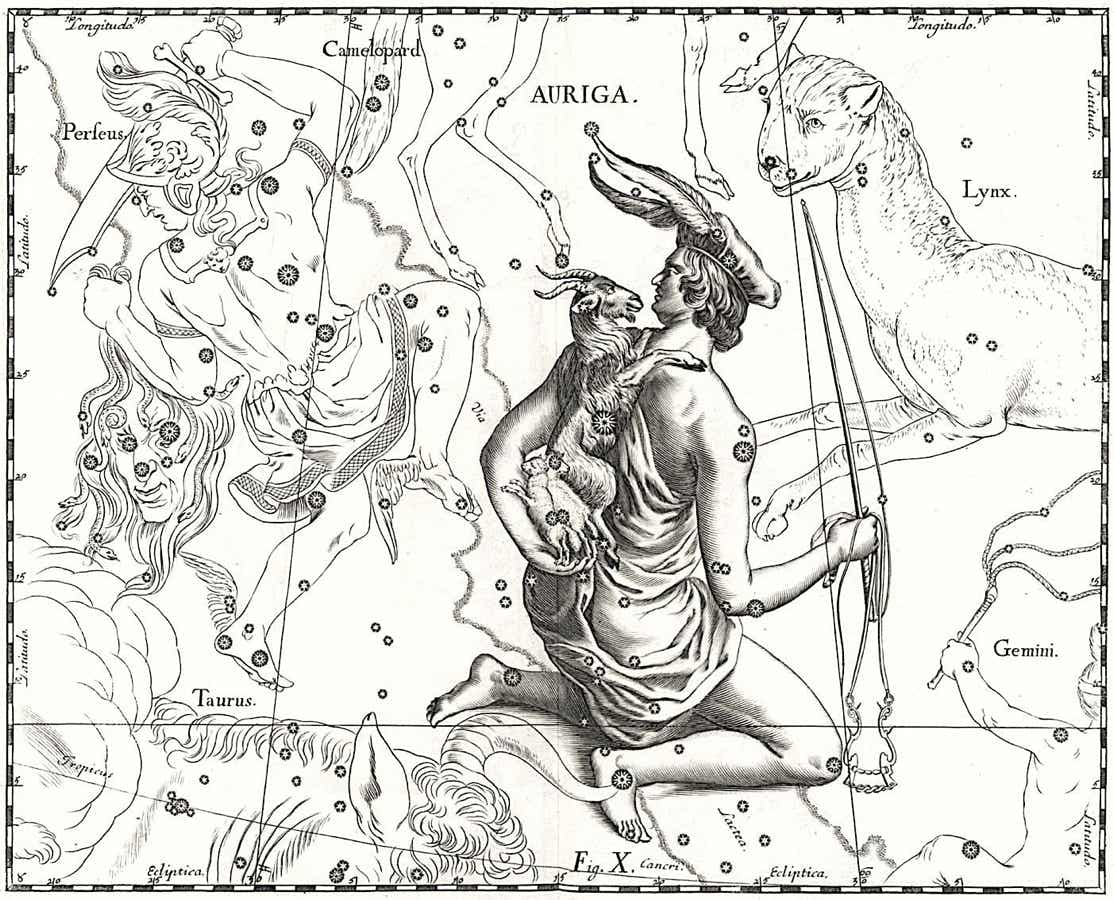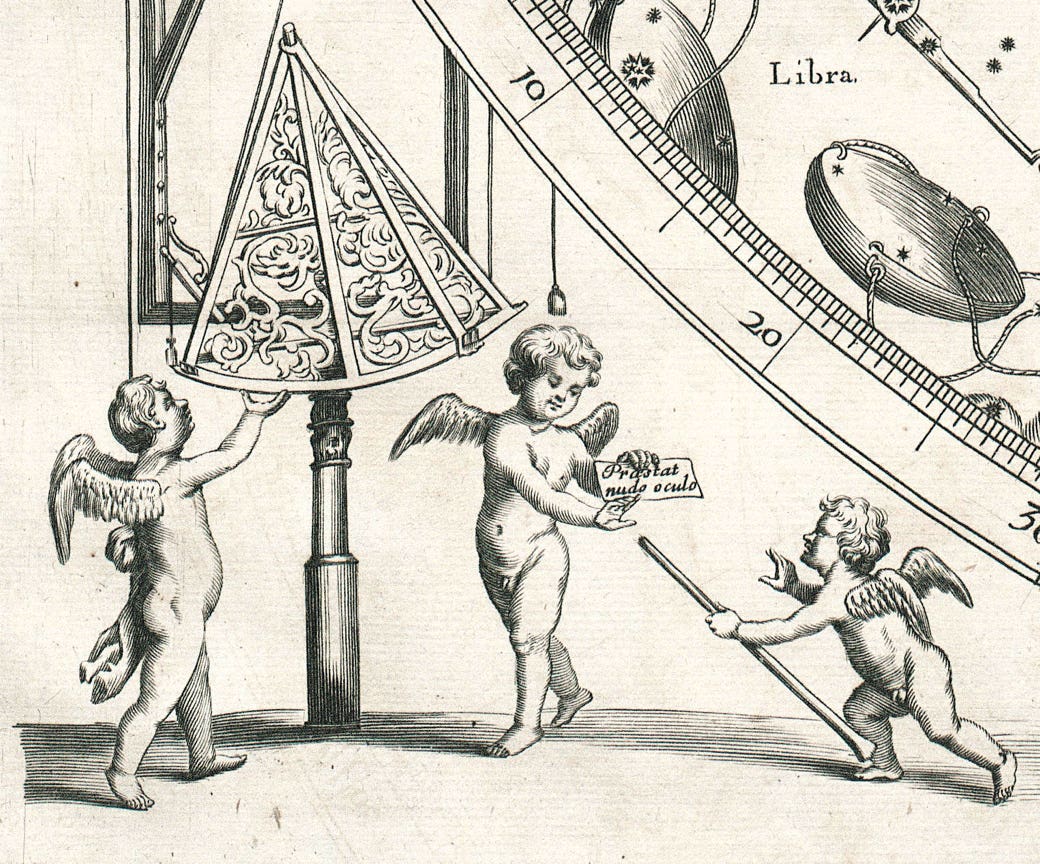From hemispheres to atlases
The first true star atlas (i.e. a set of charts of individual constellations, as distinct from hemispheres such as Dürer’s) was published in 1540 by the Italian astronomer Alessandro Piccolomini (1508–79) in a book called De le stelle fisse (On the fixed stars). Piccolomini’s atlas depicted the constellations viewed as seen from Earth, rather than as on a globe as Dürer and his followers had shown them, thereby making the charts easier for observers to use. Piccolomini included stars down to 4th magnitude taken from the catalogue in the Almagest, with fainter stars in some cases to help fill out the constellation shape. However, his charts were quite crudely drawn and lacked the classical constellation figures that were a major feature of the magnificent pictorial atlases that were to come.
Bayer’s Uranometria
Star maps improved as astronomers surveyed the sky in more detail and with greater accuracy. The first great star atlas was produced in 1603 by Johann Bayer (1572–1625), a lawyer in Augsburg, Germany, who had a passion for astronomy. His Uranometria atlas[note] devoted one large chart to each of the 48 Ptolemaic constellations, using star positions from Ptolemy’s Almagest and from the recently released catalogue by the great Danish observer Tycho Brahe. The southern skies not in Ptolemy’s catalogue were allocated one map, depicting the 12 new constellations based on stars observed by the Dutch navigator Pieter Dirkszoon Keyser. A pair of northern and southern hemisphere charts brought the total to 51.
In all, over 1,700 stars are plotted, 700 more than listed in the Almagest. So popular was the Uranometria that it was reissued several times throughout the 17th century. Its exquisitely engraved charts by Alexander Mair (c.1559–c.1620), a German artist and fellow-resident of Bayer’s in Augsburg, are true works of art.
Johann Bayer’s landmark star atlas of 1603 called Uranometria devoted individual charts to each of the 48 Greek constellations. Here Hercules is seen holding a branch from the golden apple tree of the Hesperides. The stippled area at right is the Milky Way. Bayer’s Uranometria was highly popular on account of its comprehensiveness, its artistic quality, and its introduction of the system of labelling stars with Greek letters.
(David Rumsey Historical Map Collection)
Bayer’s atlas was notable for another reason: it introduced the convention of labelling bright stars by Greek letters, a system that astronomers still use. These are now commonly termed Bayer letters. For example, the bright star Betelgeuse is also known on this scheme as Alpha (α) Orionis, meaning Alpha of Orion (the genitive, or possessive, case of the constellation name is always used). Since the measurement of star brightnesses was not a very precise art in those days, the sequence of Greek letters assigned by Bayer only approximately follows the sequence of stellar brightnesses in each constellation. In a number of cases, the star marked Alpha is not the brightest, as in Orion, where Beta Orionis (Rigel) is the brightest star. Gemini is another prominent constellation in which the star Beta is brighter than Alpha.
Bayer did not assign Greek letters to the southern constellations of Keyser, perhaps reasoning that such a move would be premature. The Bayer lettering system was extended to the southernmost sky 160 years later by the French astronomer Nicolas Louis de Lacaille, on his map published in 1763. Constellations in the northern sky that were introduced subsequent to Bayer’s time were allocated Greek letters by the English astronomer Francis Baily (1774–1844) in his British Association Catalogue of 1845, although only down to mag. 4.5.
Hevelius and the Firmamentum Sobiescianum
A few years after Bayer’s Uranometria appeared, astronomy was revolutionized by the invention of the telescope, which not only revealed faint stars that had hitherto been invisible but also greatly improved the accuracy with which star positions could be measured. One man remained unmoved by this advance: Johannes Hevelius (1611–87), an astronomer from Danzig (the modern Gdańsk in Poland). Stubbornly, Hevelius continued to measure star positions with naked-eye sights throughout his life, worrying that lenses might introduce positional distortions.[note]
Hevelius’s catalogue of over 1,500 star positions, Catalogus Stellarum Fixarum, was published posthumously in 1690. The catalogue contained 50% more stars than that compiled by the great Tycho Brahe a century earlier and the positional measurements were of comparable accuracy. Accompanying Hevelius’s catalogue was an atlas of 56 plates, Firmamentum Sobiescianum, engraved with great skill by the French engraver Charles de la Haye (1641–17??). In this atlas and catalogue Hevelius introduced ten new constellations in the northern sky. For the southern stars, which he showed on a separate chart, Hevelius used the observations made by the English astronomer Edmond Halley from the island of St Helena, which were an improvement on those of the pioneering Dutchmen Pieter Dirkszoon Keyser and Frederick de Houtman.
Firmamentum Sobiescianum suffers from the drawback that the constellation figures are depicted back to front, as they would appear on a celestial globe (see the example below); this makes it difficult for an observer to match up the star patterns to the real sky. For this reason the Hevelius maps are not used for the constellation illustrations on these pages. Another disadvantage is that Hevelius did not label his stars with Bayer letters, nor any other form of identification such as a name or catalogue number.
Johannes Hevelius’s influential star atlas Firmamentum Sobiescianum was dated 1687, the year of his death, but not published until 1690. Hevelius introduced ten new constellations, of which seven are still accepted by astronomers today. His atlas portrayed the constellation figures from the rear, as they would appear on a celestial globe. This led to some awkward-looking representations, such as Auriga carrying the goat and kids on his back, shown here. There were no Bayer letters or any numbering on Hevelius’s charts which makes it difficult to identify the stars.
© Ian Ridpath. All rights reserved
Or, to give it its full title, Uranometria, omnium asterismorum continens schemata, nova methodo delineata, aereis laminis expressa, meaning ‘Uranometria, containing charts of all the constellations, drawn by a new method and engraved on copper plates’.
Hevelius embedded an ‘Easter egg’ message to this effect in the lower left corner of his chart of the northern sky. In this little tableau a putto, or cherub, observes with a sextant while his companion declines the offer of a telescope, holding up a sign saying ‘the naked eye is better’ (Præstat nudo oculo).
◄ PREVIOUS
NEXT ►




